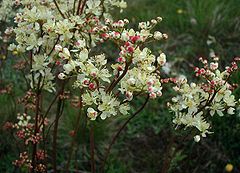Filipendula vulgaris: Difference between revisions
Jump to navigation
Jump to search
Created page with '{{SPlantbox |familia=Rosaceae |genus=Filipendula |species= vulgaris |common_name=Filipendula hexapetala |name_ref=Flora - A Gardener's Encyclopedia ISBN 0881925381 |habit=bulbous…' |
No edit summary |
||
| Line 2: | Line 2: | ||
|familia=Rosaceae | |familia=Rosaceae | ||
|genus=Filipendula | |genus=Filipendula | ||
|species= vulgaris | |species=vulgaris | ||
|common_name=Filipendula hexapetala | |common_name=Filipendula hexapetala | ||
|name_ref=Flora - A Gardener's Encyclopedia ISBN 0881925381 | |name_ref=Flora - A Gardener's Encyclopedia ISBN 0881925381 | ||
|habit= | |habit=herbaceous | ||
|habit_ref= | |habit_ref=Wikipedia | ||
|Min ht box=24 | |Min ht box=24 | ||
|Min ht metric=in | |Min ht metric=in | ||
| Line 15: | Line 15: | ||
|Max wd metric=in | |Max wd metric=in | ||
|width_ref=Flora - A Gardener's Encyclopedia ISBN 0881925381 | |width_ref=Flora - A Gardener's Encyclopedia ISBN 0881925381 | ||
|lifespan=perennial | |||
|life_ref=Wikipedia | |||
|exposure=part-sun | |exposure=part-sun | ||
|sun_ref=Flora - A Gardener's Encyclopedia ISBN 0881925381 | |sun_ref=Flora - A Gardener's Encyclopedia ISBN 0881925381 | ||
| Line 25: | Line 27: | ||
|usda_ref=Flora - A Gardener's Encyclopedia ISBN 0881925381 | |usda_ref=Flora - A Gardener's Encyclopedia ISBN 0881925381 | ||
|max_zone=9 | |max_zone=9 | ||
|image= | |image=Filipendula-vulgaris.JPG | ||
|image_width=240 | |image_width=240 | ||
}} | }} | ||
'''Dropwort''' ('''''Filipendula vulgaris'''''), also known as '''Fern-leaf Dropwort''', is a [[perennial plant|perennial]] herb of the family Rosaceae closely related to [[Meadowsweet]]. It is found in dry [[pasture]]s across much of [[Europe]] and central and northern [[Asia]]. | |||
It has finely-cut, radical [[leaf|leaves]], fern-like in appearance, and an erect stem {{Convert|20|-|50|cm|in|sigfig=1}} tall<ref name=Stace>C A Stace, ''Interactive Flora of the British Isles, a Digital Encyclopaedia'': ''Filipendula vulgaris''. ISBN 90-75000-69-3. ([http://nlbif.eti.uva.nl/bis/flora.php?selected=beschrijving&menuentry=soorten&id=2599 Online version)]</ref> bearing a loose terminal [[inflorescence]] of small white [[flower]]s. The tiny flowers appear in dense clusters from late spring to mid summer. The crushed leaves and roots have a scent of oil of wintergreen ([[Methyl salicylate]]). | |||
==Cultivation== | ==Cultivation== | ||
This plant prefers full sun to partial shade. It is more tolerant of dry conditions than most other members of its genus. | |||
===Propagation=== | ===Propagation=== | ||
Propagation is by seed and the division of the creeping roots. | |||
===Pests and diseases=== | ===Pests and diseases=== | ||
Latest revision as of 19:57, 29 July 2010
| Filipendula vulgaris subsp. var. | Filipendula hexapetala | |||||||||||||||||||||||||||||||||||||||||||||||||||||||
|---|---|---|---|---|---|---|---|---|---|---|---|---|---|---|---|---|---|---|---|---|---|---|---|---|---|---|---|---|---|---|---|---|---|---|---|---|---|---|---|---|---|---|---|---|---|---|---|---|---|---|---|---|---|---|---|---|

|
|
| ||||||||||||||||||||||||||||||||||||||||||||||||||||||
| ||||||||||||||||||||||||||||||||||||||||||||||||||||||||
Dropwort (Filipendula vulgaris), also known as Fern-leaf Dropwort, is a perennial herb of the family Rosaceae closely related to Meadowsweet. It is found in dry pastures across much of Europe and central and northern Asia.
It has finely-cut, radical leaves, fern-like in appearance, and an erect stem 20 - 50 cm tall[1] bearing a loose terminal inflorescence of small white flowers. The tiny flowers appear in dense clusters from late spring to mid summer. The crushed leaves and roots have a scent of oil of wintergreen (Methyl salicylate).
Cultivation
This plant prefers full sun to partial shade. It is more tolerant of dry conditions than most other members of its genus.
Propagation
Propagation is by seed and the division of the creeping roots.
Pests and diseases
Varieties
Gallery
-
photo 1
-
photo 2
-
photo 3
References
- ↑ C A Stace, Interactive Flora of the British Isles, a Digital Encyclopaedia: Filipendula vulgaris. ISBN 90-75000-69-3. (Online version)
External links
- w:Filipendula vulgaris. Some of the material on this page may be from Wikipedia, under the Creative Commons license.
- Filipendula vulgaris QR Code (Size 50, 100, 200, 500)
